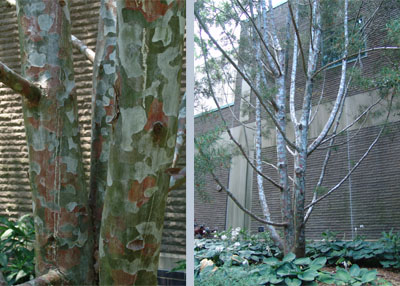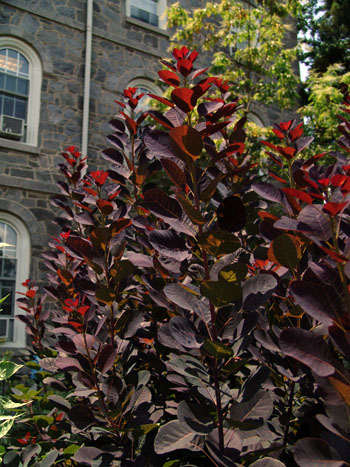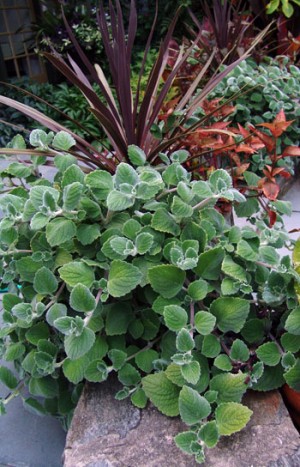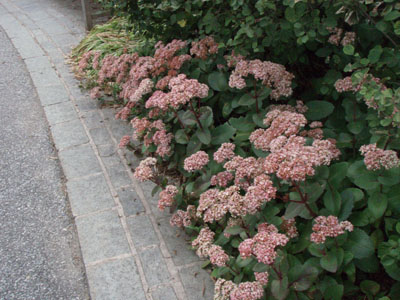Plants of the Week – July 9
 As evergreens, pine trees are normally celebrated for giving us winter color. Pinus bungeana, however, offers something interesting to look at year round with its beautiful bark displaying a mosaic pattern of green, yellow, and clay-red against a background of silvery gray. This tree is native to northeastern China where it can be seen everywhere including roadsides, graveyards, and temples, though it is still something of a rarity outside China. The intricate bark is not its only attractive feature though. Pinus bungeana has a graceful form, delicate foliage and has shown a wide range of tolerances, surviving both alkaline and acidic soils and temperatures above 100° and below 0°F. You must be patient with the seedlings however because they are slow growers at first, until after 10 years when they start to grow faster. We have a few Pinus bungeana beside the Lang Performing Arts Center near the Cosby Courtyard. Photo Credit: J. Ahrweiler
As evergreens, pine trees are normally celebrated for giving us winter color. Pinus bungeana, however, offers something interesting to look at year round with its beautiful bark displaying a mosaic pattern of green, yellow, and clay-red against a background of silvery gray. This tree is native to northeastern China where it can be seen everywhere including roadsides, graveyards, and temples, though it is still something of a rarity outside China. The intricate bark is not its only attractive feature though. Pinus bungeana has a graceful form, delicate foliage and has shown a wide range of tolerances, surviving both alkaline and acidic soils and temperatures above 100° and below 0°F. You must be patient with the seedlings however because they are slow growers at first, until after 10 years when they start to grow faster. We have a few Pinus bungeana beside the Lang Performing Arts Center near the Cosby Courtyard. Photo Credit: J. Ahrweiler
In German, matrona translates to “a woman with a robust form.” Sedum ‘Matrona’ lives up to its name having a lush, full-bodied form. It is a large cultivar that can grow two to three feet tall with numerous stems which cover the ground. Its stems are upright, sturdy, and pinkish purple while its thick succulent leaves are gray-green with rosy-red edges and veins. It is a wonderful foliage plant and also has attractive flower heads, which are currently in full bloom. Here at Swarthmore you can find this sedum growing along the Rose Garden Circle. Photo Credit: J. Ahrweiler
 Another attractive plant found in the Rose Garden Circle is the small deciduous tree Cotinus coggygria ‘Royal Purple’, also known as purple smoke tree. This is a fantastic accent plant as it has beautiful burgundy foliage spring through fall. It can be used as a specimen or focal plant, or it can be arranged among other shrubs to accent its colors. Besides having handsome foliage, however, it also displays puffs of smoke-like blooms from spring to early summer. To make this plant even more desirable it is deer resistant and very easy to care for. Photo Credit: J. Ahrweiler
Another attractive plant found in the Rose Garden Circle is the small deciduous tree Cotinus coggygria ‘Royal Purple’, also known as purple smoke tree. This is a fantastic accent plant as it has beautiful burgundy foliage spring through fall. It can be used as a specimen or focal plant, or it can be arranged among other shrubs to accent its colors. Besides having handsome foliage, however, it also displays puffs of smoke-like blooms from spring to early summer. To make this plant even more desirable it is deer resistant and very easy to care for. Photo Credit: J. Ahrweiler
 Plectranthus argentatus, also known as silver spur flower, is a member of the Lamiaceae family, or the mint family. This Australian native can be seen gracing Cunningham’s front doorstep, its fuzzy gray green foliage cascading down two of the pots in our entrance display. Due to its attractive leaves and fast growth, it is a great plant in potted arrangements and as a trailing ground cover. It can be grown in sun to part shade, though tends to grow fuller given some shade. It is a perennial but is not hardy, so take it in during the winter if you wish to keep the plant. If you do choose to overwinter Plectranthus argentatus it would be beneficial to cut it back every year to rejuvenate its growth. Photo Credit: J. Ahrweiler
Plectranthus argentatus, also known as silver spur flower, is a member of the Lamiaceae family, or the mint family. This Australian native can be seen gracing Cunningham’s front doorstep, its fuzzy gray green foliage cascading down two of the pots in our entrance display. Due to its attractive leaves and fast growth, it is a great plant in potted arrangements and as a trailing ground cover. It can be grown in sun to part shade, though tends to grow fuller given some shade. It is a perennial but is not hardy, so take it in during the winter if you wish to keep the plant. If you do choose to overwinter Plectranthus argentatus it would be beneficial to cut it back every year to rejuvenate its growth. Photo Credit: J. Ahrweiler






Theo
Posted at 03:46h, 23 JulyHello Scott Arboretum,
Can you tell me something about how long it takes before Pinus bungeana develops its beautifull bark? I read different things about it, ranging from 10 to 25 years. Also, is the specimen on the photo a seedling or grafted? Someone told me that when you graft Pinus bungeana on Pinus armandii it will grow much quicker and develop its characteristic bark at an much earlier age. Thanks in advance for answering these questions. Kind regards fromTheo/The Netherlands
Michael Bruce
Posted at 17:40h, 26 JulyHello,
Though this article is 2 years old, I’m hoping someone may respond to my query regarding Cotinus? As a florist, I grow purple Smoke Bush to harvest its foliage. I am aware the plant can be severely cut back to encourage new growth. What is the latest (in the growing season) pruning can occur to encourage this (“water-sprout”) growth without harming the plant? As an aside: I enjoy walking the grounds at Scott Arboretum learning new plant materials… After viewing your Spigelia over 8 years ago (?), I purchased some and it has performed well at our home. I am also excited about my newly planted Paulownia, which I will also cut back in a similar fashion as my Cotinus, to enjoy it’s uber large leaves and discourage flowering/re-seeding in my garden. The Arboretum is a fountain of knowledge and ideas! Cheers!